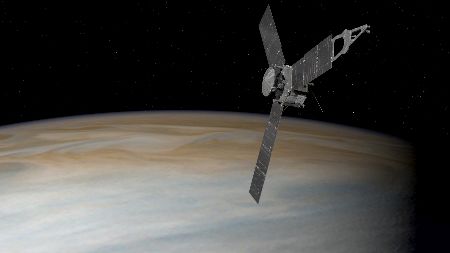July, 2016
Juno Reaches Jupiter
On Independence Day, 2016, Juno, the NASA space mission to Jupiter, arrived and began maneuvering to enter orbit about the gas giant. The journey had begun for Juno nearly five years earlier. This space quest's cost has exceeded a billion dollars. It has been described as the most complex of NASA's projects. That is saying something, considering that the space agency several times put people on the moon and safely returned them to Earth back in the 1960s to 1970s, when computing was in relative infancy and their total software use then could now fit in a single handheld calculator, and that there have been numerous subsequent complicated missions, including to Mars, Saturn and its moon, Titan, a comet, and Pluto, and, after Hubble proved disappointing due to a major defect in its mirror, NASA did a flawless and spectacularly successful follow-up extravehicular activity mission to save the disabled space telescope.
Here are a few details about the Juno mission:
- Its name is apt. First, in mythology Juno was married to Jupiter, king of the gods. Further, Juno had the magical power to see through clouds. In this case, Jupiter's thick atmosphere prevents ordinary observations into its depths, yet the Juno craft's instruments should reveal much of what was previously obscure about the largest planet.
- This is the most ambitious and distant from Earth mission powered by solar energy. That is possible due to three large solar arrays and a complicated orbit that keeps the craft out of Jupiter's shadow, allowing its panels to always face the Sun.

Artist's conception of Juno Mission spacecraft (NASA image) |
- It has traveled 1.7 billion miles to attain Jupiter orbit.
- It has already achieved the fastest speed of any NASA probe, 164,700 miles per hour, attained on 7/4/16 as the craft was caught in the massive Jovian gravity well before being inserted into Jupiter orbit.
- It is one of the more temporary probes, expected to last for only about three dozen or fewer orbits of Jupiter. Each orbit lasts for 53.5 Earth days.
- Its later deliberate destruction by NASA, scheduled for 2018, is intended to help prevent any possible contamination with Earth microbes of the second closest to Jupiter moon, Europa, an ice covered world that possesses a watery ocean and could harbor alien life.
- During its orbits of Jupiter, sensors on Juno are to help assess the planet's powerful magnetic field, its core (if indeed one exists), the amount of water present, and Jupiter's polar light shows (similar to our Aurora Borealis displays) that can be several times the diameter of Earth.
- These sensors include nine science packages, starting with a photographic observational camera and continuing with gravity science, a magnetometer, a microwave radiometer, an energetic particle detector, an auroral distributions experiment, a radio and plasma wave sensor, an ultraviolet spectrograph, and an infrared auroral mapper.
- Results of the experiments and instruments can also help researchers assess the nature of the planet's weather (with Jovian winds at times reaching about 400 mph).
- Effects on Juno of Jupiter's vast gravity, radiation, and magnetic fields plus its charged particles, some traveling close to the speed of light, will be devastating for the mission's functioning. By mission's expected end, Juno will have received the equivalent of over 100 million times the radiation of a dental x-ray. There is also the danger of collision with small meteors. Scientists are uncertain how long the scientific payload can keep operating. Even if they gather data and transmit it back to Earth for only a dozen of the intended 35 orbits, however, it will have been judged that the mission was a success for all the added information obtained.
- Juno's final descent is anticipated to occur once scientists have determined that its scientific usefulness is close to an end yet before engineers completely lose control of the deteriorating craft. Over a five day period, Juno will be slowed so it can fall into the Jovian atmosphere and burn up. No contaminants should be left to affect deeper levels of Jupiter's layered gases, its possible solid core, or any life form (no doubt quite different from our own) that may exist there.
Jupiter is by far the biggest planet in our system. Gigantic as it is, though, it is far too small to have become a second sun, making ours a binary star system. Yet Jupiter occupies 1321 times the volume of Earth. It alone contains more than two-thirds of the total planetary mass orbiting Sol. Its effect on the evolution of the early Solar System was appropriately huge. Without Jupiter's gravity pulling in many of the millions of things floating or crashing about in the early history of the planets, there would have been too many and great impacts on Earth's surface to permit life as we know it to have developed.
Jupiter is believed to still in many ways be like it was billions of years ago. By our learning much more about this world, current models of the formation of the Solar System can be refined. They, in turn, can give us better windows on the evolution of other planetary systems throughout our Milky Way galaxy.
|
